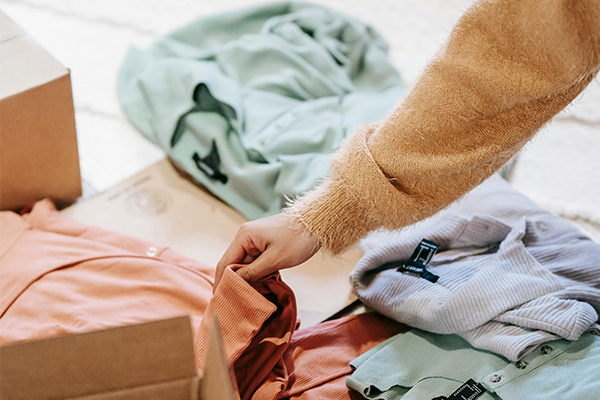As we increasingly move to buying clothes online, it’s worth asking the question: what happens to all of our online shopping returns?
As many as 88 per cent of us assume that clothes are simply resold, but the truth is that returned items are much less likely to be sold again than we might hope—and sadly, they come with some serious environmental and social red flags.
Australian Online Spending Habits
Australia Post released their 2024 e-commerce industry report earlier in March, and revealed that Australians spent $63.6B online last year, with one in seven Aussies making an online purchase more than once a week.
According to Australian Circular Fashion Association founder Camille Reed, 30 per cent of all online purchases are returned and a further 30 percent of these returns cannot be resold because of damage, season timing or processing cost, a staggering amount considering Australians spent $9.6B on online fashion purchases in 2023.
A higher returns-rate just comes with the territory of online shopping. Despite the clearest photos, sizing charts and so on, it’s hard to overcome the fact that shoppers didn’t get the chance to try on the item or assess the quality–in fact, size and fit account for 45 per cent of returns.
Two other practices that lead to online returns are ‘bracketing’ and ‘wardrobing’. If you haven’t heard of these terms before, bracketing refers to something that 63 per cent of online shoppers do; ordering several sizes up or down of the item you want, keeping the piece that fits, and returning the rest. Wardrobing refers to the deceptive practice of wearing a purchase for an occasion and then returning it once you’ve worn it—much easier to get away with when you don’t have to be dishonest face to face with a sales assistant!
Returns Aren’t As Easy As The Click Of A Button
When a customer returns their online purchase, it’s transported back to a distribution centre or sorting facility that could be states or even oceans away. The packaging the customer shipped the return in is then opened and discarded as workers check the condition of the item—have tags been removed? Is it stained with makeup?
At this point, the item could be deemed unfit for resale and sent to a recycling center, charity, discount sale or landfill. Or if it can be resold, it may require cleaning, steaming, re-organising and repackaging to eventually be sent to the next customer.
Here are some factors that the brand might consider when deciding the fate of a returned item.
- How much did it sell for? When the original price was low to begin with, companies aren’t incentivised to transport, check, clean, repackage and resell the item, as the time and money involved in that process costs more than the garment.
- When was it returned? With 30 or 60-day return windows and the time it takes to ship, it’s possible that the item has sold out or been discounted and can’t be sold again to recoup the original and processing costs.
- What will donating or discounting this item do to our brand image? Brands seek to create a curated image, whether that’s class, youthfulness, luxury and scarcity. If swathes of returned items are suddenly filling the streets, worn by people who sourced them from a charity, it could be at odds with the image a brand is trying to represent.

Even Free Returns Are Expensive
Each step of the returns process has some financial cost and manual labour attached to it. As online shopping grows in popularity along with practices like wardrobing and bracketing, companies are forced to factor this into their pricing models. This can be done either by increasing prices for consumers, or looking for ways to lower their costs of production.
With garment workers already likely to be paid below a living wage, and materials being made as cheaply as possible, the need to account for the additional cost of returns processing threatens a brand’s ethics throughout their supply chain.
Environmental Concerns
Processing returns leads to a duplication of logistics emissions created by road, sea or air freight, and waste from packaging and labeling. It’s also not unheard of for clothes be sent straight to landfill—in fact, in the US alone, that happens to five million tons of online shopping returns. Brands may have a recycling process in place for these items. Keeping the resources in use is better than sending the garment to landfill, but this still has an environmental impact. Resources like cotton and water and the garment’s production footprint, from greenhouse gas and chemical emissions, haven’t been neutralised through years of use, as the item is sent straight back to the start of the lifecycle.
What Are Brands Doing About It?
There are different ways to address this problem, and you’ll see brands trying various things.
Some major online retailers have introduced a returns fee to discourage customers from returning goods, but waive this fee for those that drop returns of to a physical store. Others are continuing to offer generous returns policies, arguing that satisfied customers are less likely to return items. This issue is something that brands will continue to need to adapt and respond to, without forgoing their commitments to continue improving their environmental and social footprint.
What Can We Do About It?
- Think twice before engaging in practices of wardrobing. Try embracing the joy of outfit-repeating, borrowing from a friend, or shopping second-hand if you need something for a specific event.
- Look for ways to reduce bracketing. Consider going to the physical store to check what size or fit you need, instead of adding a ‘just-in-case’ buffer to your online purchases. Alternatively, as well as a brands’ own sizing tool or contact center, there are a growing number of Facebook groups dedicated to helping shoppers with sizing and true fit.
- Ask what the brand’s returns procedure is. There are lots of ways brands deal with their online returns, some much better than others.
- Invest in pieces from brands that adopt slower fashion principles, where possible. If you are able, consider making an online purchase from a brand that produces quality ethical garments, that may release fewer each year. This increases the chances that what you return can be resold.
As with any challenge, it will take collaboration and investment from a variety of stakeholders to make progress, but there are small steps that we can take to do our bit.



 Bonnie Graham,
Bonnie Graham,
